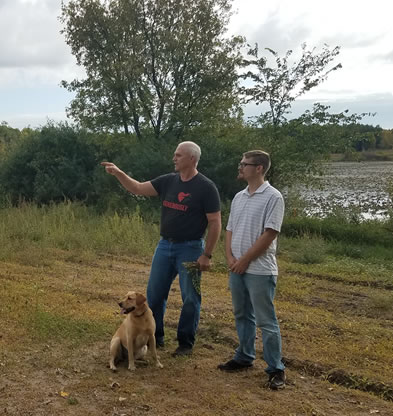Farmer Sees Conservation Opportunity in Buffer Law
In Barry Springborn’s front yard, prairie grasses and flowers buzz with pollinators. The driveway on this family farm outside Cambridge in Isanti County is lined with blooming partridge pea. Bumblebees feed on the yellow flowers. Song sparrows sing from the tall grasses swaying in the wind. Sandhill cranes fly overhead. Trumpeter swans appear on the far edge of Johnny’s Lake. The Springborn farm is perched above the small, shallow lake. Recently installed buffers will protect water quality and provide wildlife habitat.
Springborn raises beef cattle and corn. In 2017, he planted a buffer adjacent to Johnny’s Lake with a pollinator seed mix in accordance with Minnesota’s riparian buffer law.
“When the buffer strip requirement came along, at first I was confused. I had some conversations with staff from the Isanti Soil & Water Conservation District (SWCD), and they helped me get in touch with students at Anoka-Ramsey Community College that were conducting a pollinator study. The college supplied the pollinator flower seed, and I contacted a private vendor to get a native grass mix that would work with the flower mix,” Springborn said.
Barry Springborn's farm sits above Johnny's Lake just outside Cambridge in Isanti County. After the buffer was planted, the students compared the Springborn’s buffer to non-buffered areas. They found that an increase in flowering plants increased the variety of pollinators. Springborn saw the new buffer law as an opportunity to provide more wildlife habitat.
According to Springborn, the young hunter he hosted for Youth Waterfowl Day in early September harvested a teal from a small wetland on the farm. Springborn said he felt fortunate that Springvale County Park, which lies across the lake, borders his farm. The Isanti County park consists of 211 acres of wetlands, woodlands and grasslands — which provide even more critical habitat for wildlife, and protect water quality.
“I love the outdoors and hunting and fishing. It never ceases to amaze me when hunters talk about game populations and always refer to the weather as the No. 1 factor that drives this. Very rarely do I hear them talking about the habitat — where wildlife nest, raise young and have protection all year, including winter,” Springborn said.
In fall 2018, Springborn seeded a forested buffer in another spot adjacent to Johnny’s Lake. Weeds were controlled over the summer, and the site was prepared for seeding. He worked with the Minnesota Department of Natural Resources to seed white oak, bur oak, red oak, swamp white oak, wild plum, high bush cranberry and dogwood into the buffer.
Springborn said he planned to pursue more conservation practices.
“In total, since the Buffer Law, I have planted 4 acres for pollinators plus 6.6 acres of trees that are bordering wetlands. Next spring I plan on putting another 2 acres into prairie. Most of this is above and beyond what the Buffer Law requires. When the Buffer Law came in, it just encouraged me to get more aggressive in creating habitat.”

